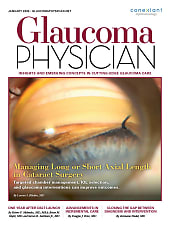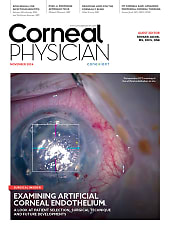Systemic chemotherapy is the most common method of treatment for cancer. Newer antineoplastic agents have offered improved survival rates for aggressive malignancies; however, in some cases they may cause ocular side effects.1 These toxicities can range from mild effects, which allow the patient to continue the therapy, to acute vision-threatening effects that require at least temporary drug cessation.
To promote early treatment and minimize severe complications when these events occur, this article aims to review the various ocular effects of several classes of systemic chemotherapy drugs, including immune checkpoint inhibitors (ICIs), ALK inhibitors, MEK inhibitors, BRAF inhibitors, and EGFR inhibitors.

Figure 1. A 61-year-old male with metastatic cutaneous melanoma presented with subjectively decreased vision in both eyes. Systemic treatment included encorafenib, a BRAF inhibitor, and binimetinib, a MEK inhibitor. Visual acuity was preserved at 20/20 in the right eye and 20/20-2 in the left eye. Optical coherence tomography (OCT) of the right (A) and left (B) eye demonstrated a sliver of macular subretinal fluid, also called a “splitting” configuration. The systemic agents were not discontinued. When the patient returned 1 month later, the subretinal fluid had spontaneously resolved. Images courtesy Kapil Mishra, MD.
Immune Checkpoint Inhibitors
ICIs are a commonly used immuno-therapy in cancer treatment. Immune checkpoint proteins on T cells bind to partner proteins on neighboring cells to deactivate T cells.2 Some cancer cells express partner proteins to deactivate T cells and evade an immune response. ICIs inhibit the binding of immune checkpoint proteins and their partner proteins to prevent the deactivation of T cells.2
Immune checkpoint inhibitors treat cancer by upregulating the activity of the body’s immune system. However, this can also lead to adverse immune responses in other parts of the body, including the eye. Fortes et al found that in a study of 996 patients, only 28 of them (2.8%) returned to their physician to address ocular side effects after immune checkpoint inhibitor therapy.3 The most common side effects reported were dry eye syndrome and uveitis, with rarer single cases such as retinal detachment or Vogt-Koyanagi-Harada (VKH)–like syndrome. Out of all patients reporting ocular adverse events (AEs) in this study, only 1 patient required permanent discontinuation of ICI therapy due to their symptoms. All patients reporting ocular AEs had their symptoms resolved, controlled with treatment, or did not follow up to the clinic.
PD-1 is an immune checkpoint protein that is commonly targeted with immune checkpoint therapy. In a meta-analysis performed by Hou et al, PDL-1/PD-1 inhibitor therapies such as pembrolizumab and nivolumab produced fewer ophthalmic AEs compared to CTLA-4 inhibitor therapy.4 When multiple ICIs were combined with PD-1 inhibitor therapy, more ophthalmic AEs occurred.
Uveitis is a potentially vision-threatening side effect associated with immune checkpoint inhibitor therapy that occurs in about 1% of patients.5 Presentations range from mild acute anterior uveitis to dense vitritis with choroidal effusions. Treatments typically involve local therapy to avoid systemic steroid use, but in some severe cases patients may require intravenous infusion of steroid as well as ICI drug cessation. Symptoms can take as little as a few days to resolve, or as long as a year.6
Dry eye disease (DED) is the most frequent ocular side effect reported in patients treated with immune checkpoint inhibitor therapy.7 Up to 24% of patients undergoing ICI therapy report having dry eye syndrome, and treatment typically consists of using artificial tear drops, ointments, or gels.7,8 While they are a common side effect, DED symptoms are temporary and usually do not require patients to discontinue their ICI therapy.
A study by Francis et al in 2020 examined optic neuritis in 11 patients receiving immune checkpoint inhibitor therapy and followed their clinical outcomes.9 In contrast with the typical symptoms of optic neuritis, patients presenting with optic neuritis demonstrated a pattern of painless bilateral visual decline with a lower incidence of color vision loss. Each patient reporting optic neuritis discontinued ICI chemotherapy and was treated with steroids, plasmapheresis, intravenous immunoglobulin, or rituximab.
Ocular AEs can redirect a patient’s treatment plan if they pose a significant threat to a patient’s long-term visual health or quality of life. In the future, studies examining the long-term consequences of ocular AEs on patients’ chemotherapy treatment and outcomes may provide greater context for clinical decision-making.
ALK Inhibitors
ALK inhibitors are newer tyrosine kinase inhibitors used to treat non–small cell lung carcinoma. These drugs target anaplastic lymphoma kinase (ALK), an oncogenic gene commonly mutated in NSCLC.10,11 A PubMed literature search conducted by Chelala et al revealed that ocular side effects occurred in 7.3% of patients treated with brigantinib, 13% treated with lorlatinib, 41 to 71% treated with crizotinib, 9% treated with ceritinib, and 6% treated with alectinib.12 One patient was reported to have optic neuropathy after treatment with crizotinib, and another patient suffered from macular edema.
Crizotinib is an ALK inhibitor that is known to have ocular side effects. Common side effects include visual effects, such as flashes or light trails, that typically begin within the first 2 weeks of treatment.13 Importantly, these visual effects are temporary and do not require patients to change or discontinue their therapy.14
MEK Inhibitors
MEK inhibitors are another type of chemotherapy treatment that target MEK 1 and MEK 2, proteins that play a critical role in the development of certain melanomas, colorectal cancers, and non–small cell lung cancers.15 Rare ocular AEs associated with MEK inhibitor treatment include uveitis, retinal disease (vein occlusions and retinopathy), and dry eye disease.16 Most side effects are mild and transient, requiring only topical steroids if inflammation is present.16 Retinal vein occlusion may be an indication to discontinue MEK inhibitor therapy; however, there should be diligent investigation to make sure the occlusion is not due to the underlying malignancy or other hematologic abnormalities.
MEK-associated retinopathy (MEKAR) is a self-limiting but potentially recurrent condition that may present as multifocal serous retinal detachments initially confused as central serous chorioretinopathy (CSCR). Factors that may help differentiate from CSCR include no choroidal thickening, unlikely to have pigment epithelial detachment (PED), and unlikely to have fluid guttering present on fundus autofluorescence (Figure 1).
BRAF Inhibitors
BRAF inhibitors are commonly used to treat patients with BRAF-induced melanomas by targeting the MAPK pathway that plays a role in cellular division.17,18 A study by Choe et al reported that patients undergoing treatment with BRAF inhibitor vemurafenib experienced dry eye, uveitis, and conjunctivitis, all of which were successfully managed during the course of each patient’s treatment.19
Due to a shared involvement in the MAPK signaling pathway, MEK inhibitors are often paired with BRAF inhibitors in the treatment of BRAF-induced metastatic melanoma.18 Unsurprisingly, MEK/BRAF inhibitor therapy is also known to produce ocular side effects similar to the effects seen in MEK or BRAF monotherapy. Cases of uveitis and chorioretinopathy have been reported in patients undergoing MEK/BRAF inhibitor treatment.20
EGFR Inhibitors
EGFR inhibitors are another common drug class that is widely used in cancer therapy. EGFR is a protein involved in various pathways related to angiogenesis and cancer cell proliferation, and EGFR inhibitors such as gefitinib and erlotinib work to suppress the EGFR protein and decrease the spread of cancer.21 For ocular tissue, EGFR normally works to maintain the cornea and conjunctival epithelium.22,23 Thus, ocular side effects are common with the use of EGFR inhibitors. Other reported side effects include conjunctivitis, eyelash trichomegaly, and dry eyes.24
Conclusion
Although the ocular side effects of systemic chemotherapy have been studied, more research is needed to understand how ocular side effects can alter treatment plans and ultimately affect patient outcomes. Chemotherapy may trigger AEs, which may jeopardize a patient’s vision or greatly impact their quality of life. Consistent communication between the ophthalmologist and oncologist is necessary and may avoid unnecessarily discontinuing the agent.
In the future, conducting larger institution-wide studies could highlight the clinical implications of ocular side effects and provide more information for physicians to optimize each patient’s quality of life and treatment options. NRP
References
1. Liu CY, Francis JH, Abramson DH. Ocular side effects of systemically administered chemotherapy. UpToDate. May 8, 2024. Accessed August 21, 2024. https://www.uptodate.com
2. Abdou Y, Pandey M, Sarma M, Shah S, Baron J, Ernstoff MS. Mechanism-based treatment of cancer with immune checkpoint inhibitor therapies. Br J Clin Pharmacol. 2020;86(9):1690-1702. doi:10.1111/bcp.14316
3. Fortes BH, Liou H, Dalvin LA. Ophthalmic adverse effects of immune checkpoint inhibitors: the Mayo Clinic experience. Br J Ophthalmol. 2021;105(9):1263-1271. doi:10.1136/bjophthalmol-2020-316970
4. Hou YL, Wang DY, Hu JX, et al. Risk of ophthalmic adverse events in patients treated with immune checkpoint inhibitor regimens: a systematic review and meta-analysis. Ocul Immunol Inflamm. 2022;30(6):1449-1459. doi:10.1080/09273948.2021.1890133
5. Dalvin LA, Shields CL, Orloff M, Sato T, Shields JA. Checkpoint inhibitor immune therapy: systemic indications and ophthalmic side effects. Retina. 2018;38(6):1063-1078. doi:10.1097/IAE.0000000000002181
6. Dow ER, Yung M, Tsui E. Immune checkpoint inhibitor–associated uveitis: review of treatments and outcomes. Ocul Immunol Inflamm. 2021;29(1):203-211. doi:10.1080/09273948.2020.1781902
7. Vitiello L, Lixi F, Coco G, Giannaccare G. Ocular surface side effects of novel anticancer drugs. Cancers. 2024;16(2):344. doi:10.3390/cancers16020344
8. Gilbard JP. The diagnosis and management of dry eyes. Otolaryngol Clin North Am. 2005;38(5):871-885. doi:10.1016/j.otc.2005.03.012
9. Francis JH, Jaben K, Santomasso BD, et al. Immune checkpoint inhibitor–associated optic neuritis. Ophthalmology. 2020;127(11):1585-1589. doi:10.1016/j.ophtha.2020.05.003
10. Golding B, Luu A, Jones R, Viloria-Petit AM. The function and therapeutic targeting of anaplastic lymphoma kinase (ALK) in non–small cell lung cancer (NSCLC). Mol Cancer. 2018;17:52. doi:10.1186/s12943-018-0810-4
11. Miyanaga A, Shimizu K, Noro R, et al. Activity of EGFR-tyrosine kinase and ALK inhibitors for EML4–ALK-rearranged non–small cell lung cancer harbored coexisting EGFR mutation. BMC Cancer. 2013;13(1):262. doi:10.1186/1471-2407-13-262
12. Chelala E, Hoyek S, Arej N, et al. Ocular and orbital side effects of ALK inhibitors: a review article. Future Oncol Lond Engl. 2019;15(16):1939-1945. doi:10.2217/fon-2018-0608
13. O’Bryant CL, Wenger SD, Kim M, Thompson LA. Crizotinib: a new treatment option for ALK-positive non–small cell lung cancer. Ann Pharmacother. 2013;47(2):189-197. doi:10.1345/aph.1R002
14. Camidge DR, Bang YJ, Kwak EL, et al. Activity and safety of crizotinib in patients with ALK-positive non–small cell lung cancer: updated results from a phase 1 study. Lancet Oncol. 2012;13(10):1011-1019. doi:10.1016/S1470-2045(12)70344-3
15. Braicu C, Buse M, Busuioc C, et al. A comprehensive review on MAPK: a promising therapeutic target in cancer. Cancers. 2019;11(10):1618. doi:10.3390/cancers11101618
16. Han J, Chen J, Zhou H, Hao L, Wang Q. Ocular toxicities of MEK inhibitors in patients with cancer: a systematic review and meta-analysis. Oncology (Williston Park). 2023;37(3):130-141. doi:10.46883/2023.25920987
17. Welsh SJ, Corrie PG. Management of BRAF and MEK inhibitor toxicities in patients with metastatic melanoma. Ther Adv Med Oncol. 2015;7(2):122-136. doi:10.1177/1758834014566428
18. Gavric AU, Ocvirk J, Mekjavic PJ. Ocular changes in metastatic melanoma patients treated with MEK inhibitor cobimetinib and BRAF inhibitor vemurafenib. Radiol Oncol. 2018;52(2):213-219. doi:10.2478/raon-2018-0002
19. Choe CH, McArthur GA, Caro I, Kempen JH, Amaravadi RK. Ocular toxicity in BRAF mutant cutaneous melanoma patients treated with vemurafenib. Am J Ophthalmol. 2014;158(4):831-837.e2. doi:10.1016/j.ajo.2014.07.003
20. Heinzerling L, Eigentler TK, Fluck M, et al. Tolerability of BRAF/MEK inhibitor combinations: adverse event evaluation and management. ESMO Open. 2019;4(3):e000491. doi:10.1136/esmoopen-2019-000491
21. Ayati A, Moghimi S, Salarinejad S, Safavi M, Pouramiri B, Foroumadi A. A review on progression of epidermal growth factor receptor (EGFR) inhibitors as an efficient approach in cancer targeted therapy. Bioorganic Chem. 2020;99:103811. doi:10.1016/j.bioorg.2020.103811
22. Höllhumer R, Moloney G, Jacob K. Corneal edema with a systemic epidermal growth factor receptor inhibitor. Can J Ophthalmol. 2017;52(3):e96-e97. doi:10.1016/j.jcjo.2016.11.018
23. Parrozzani R, Lombardi G, Midena E, et al. Ocular side effects of EGFR inhibitor ABT-414 in recurrent glioblastoma: a long-term safety study. Front Oncol. 2020;10:593461. doi:10.3389/fonc.2020.593461
24. Basti S. Ocular toxicities of epidermal growth factor receptor inhibitors and their management. Cancer Nurs. 2007;30(4):S10. doi:10.1097/01.NCC.0000281759.23823.82










